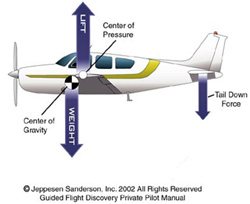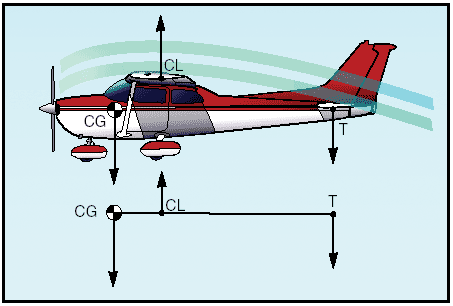The wing and the aircraft are one structure. A moment is created if 2 (or more) forces act on the same object. On our airplane, we have 3: the lift on the wing, the center of gravity (which takes into account the weight of the wings and the weight of the fuel in the wings etc) and the lift (up or down) by the tailplane. There is no other "pitching moment".PilotDAR wrote:I'm on the edge of my academic qualification in discussing C of L and C of P topics, but, I will assert that the C of G of the aircraft will not ever be aft of the center of total lift provided by the wing, including any pitching moment for the wing in that configuration. The drawn schematic does not include the pitching moment of the wing.
No, the G load is created by the fact that the wing is generating more lift than your weight. Not the other way around. Up untill Va, the aircraft will indeed stall before it overstresses. However, the 'normal' way would be that the angle of attack of the wing increases over the critical angle of attack, thus the main wing will stall. The tail has nothing to do with the stalling itself. It helps you to increase the AoA, and afterwards to decrease it again to get out of the stall. Maybe you can stall the tailplane first in some exotic cases, but that shouldn't happen in 'normal' stalls.PilotDAR wrote: The higher the G loading acting on the plane, the more load acts downward through the C of G. Therefore, to remain in equilibrium, the higher the lift must be from the wing, through its center of lift. Therefore the greater the downforce must be from the tail to balance the increased lift produced by the wing, from the combination of increased AoA and/or speed. This is how Va is determined, the speed at which the aircraft stalls before it is overstressed. The tail stalls, and releases the download, which reduces that angle of attack of the wing, thus preventing overstressing. Faster than Va, the tail is capable of exerting so much down force that, the wing can be overstressed.
That's exactly my point. You can not deduce that from your graph. This has nothing to with upward or downward acting forces specifically, but with the stability characteristics of that plane.PilotDAR wrote:
It's not the force on the elevator control, but the change in force per change in G (with no change in trim) which matters. In the graph I presented, the equilibrium point is 70 knots, where I have trimmed out the pitch force to zero, from there, I did not retrim, but measured the force on the stick as I slowed, and changed power. When you see my results showing a push force as the plane slowed, and worse a pitch force which did not change as the speed further reduced, you are seeing a plane which is very unstable, and difficult to fly. I cannot tell you if the tail was actually lifting at that point, or just providing a very small down force relative to all other forces, but it was not approvable. If it actually was lifting, it would just be the same or worse than what I measured, and certainly not approvable.











